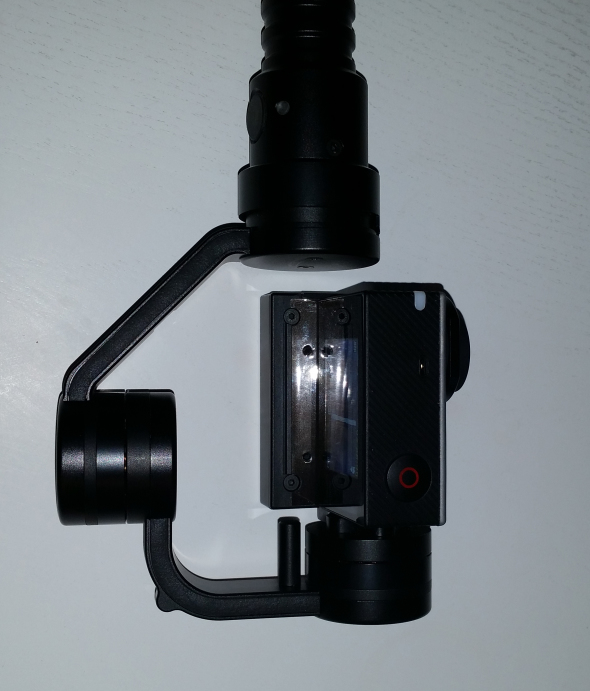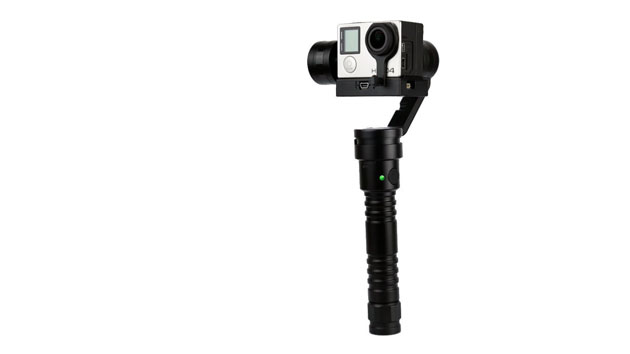The Price Is Right for This Handheld Gizmo That Gives You Smooth GoPro Footage for a Song
If you asked me when I started writing about this industry nearly 20 years ago if I'd ever be doing a review of something from Polaroid — the company that makes instant cameras — I would have thought you were crazy.
Well, it's now 2017 and we have seen quite a few brand names of the past resurrected for new products. My 40-inch RCA LCD TV, Vivitar action cam and Polaroid three-axis gimbal have nothing in common except they carry the brands of well-known American companies that went bankrupt over the last 15 or so years whose names and logos have been brought back to life and slapped on Chinese electronics. Let's see how this Polaroid does.
The gimbal doesn't come with much, just what you need. The contents of the box include the gimbal, three rechargeable batteries and charger, USB cable, instructions, and a small piece of metal that goes around the action cam's lens to hold it in place.

The gimbal is pretty rugged — the major components are made out of metal. Once the batteries are charged by plugging the charger into the USB port of a computer, they can be slipped into the handle. The gimbal's camera platform seems meant to hold a GoPro Hero 4 Black with the optional LCD BacPac panel. For the Hero3 and Hero3+, there is an included bracket, allen key and some screws to fill in the gap. The ring that goes over the camera's lens can be a bit tight. When I was trying to remove my camera, it was so tight I worried I'd break the camera's lens off. The solution was to slowly work the ring back and forth, clockwise and counter-clockwise, until it came loose. You must have patience.

Once you have the camera mounted, you must calibrate the gimbal. This is a simple process. You hold the gimbal up straight, hold the camera up straight, and then turn on the gimbal. From that point, no matter how you move, the gimbal will keep the camera in that position. This takes a couple of seconds, as opposed to a few minutes for a manual stabilizer like the Steadicam Smoothie (designed for use with action cams and cell phones). And the Polaroid is incredibly easy to use. Attach the camera, calibrate, and walk. It may feel a little odd while it is working, but the smooth shots you can get while in motion are incredible. One of my cameramen tried it out and was blown away by it. In fact he told me he was “in love with that Polaroid Gimbal.”
Recently I used it for some B-roll in a music-video shoot. I was able to walk around and get great shots of the singing piano player. I was even able to simulate a crane shot. On one take, I got off balance and my hand jerked weirdly, causing the gimbal to freak out. I recalibrated it and, on another take, got the footage needed.

What's not to love? Well, it has some limitations. My son and I have enjoyed mounting the GoPro to his RC pickup truck and watching a first person view using the Wi-Fi link to my Android phone. It was like driving a rolling drone, but the footage was usually too bumpy to use except on some super-smooth floors. I wanted to try and get some better footage, so I tried mounting the gimbal on the RC truck. Going slow it seemed to do OK, but as soon as it was going faster, the gimbal went nuts, turning and tilting all over the place. I tried re-calibrating it several times, to no avail. I checked with Polaroid, and they said that it was not meant for the relatively high speed of an RC car; it’s meant to be walked with. That is a restriction I can live with.
The only other similar-sized camera I had was a Vivitar 720 30p action cam that looks a lot like a GoPro. I got the Vivitar because the kids always bug me to use the $500 GoPro. When I saw the Vivitar on sale for $30, I saw a cheap toy for the kids — and a good way to keep my GoPro safe. The Vivitar was narrower than the GoPro Hero 4 Black with the Backpack LCD, but the lens ring and included bracket for thinner cameras held it nicely. (FYI, the Vivitar quality is pretty horrific and unsuitable for serious work. More artifacts than a museum.) Curiously, while Polaroid makes its own line of “Cube” action cams (I haven't tried one yet so I can't vouch for their quality), there is no way to use those cameras with the company's own gimbal. Polaroid might do itself a favor if they included more adapters in the box to fit it to other cameras.
Sample footage.
You could compare the Polaroid gimbal to the Steadicam Smoothee, a manual gimbal stabilizer that can be had for about $90 or less, but the differences are huge. While the Steadicam Smoothee is less expensive, calibration can be time consuming and takes practice to do well — and a gust of wind will ruin a shot. Getting weird angles is also challenging. The only other advantage is that, while the Polaroid can run out of battery power on a shoot, the Smoothee is un-powered. But the Polaroid takes only a second or two to calibrate, requires very little practice to get good results, and is much easier to use for shooting odd angles, as the on-board computer keeps the camera pretty smooth even if you aren't. The difference is like using a map vs. a GPS on a road trip.
If you need to get smooth footage on a budget, and your production allows you to use a GoPro, this may be a great solution, especially considering the price. It won't replace a Steadicam rig with a Canon C300 Mk 2 on board, but I would recommend the Polaroid Three-Axis Gimbal for anyone who needs smooth footage or moving B-roll on a budget.











Leave a Reply